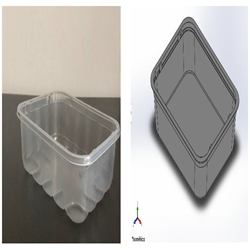The abundance of waste biomass from palm oil industries creates a new potential for producing activated carbon as catalyst support. The hydrothermal carbonization (HTC) process provides a brilliant alternative to produce activated carbon from biomass samples with higher water content than conventional pyrolysis techniques. Therefore this study aims to produce activated carbon from palm kernel shell (PKS), mesocarp fiber (MF) and empty fruit bunch (EFB) using using pyrolysis and HTC techniques.
The HTC process favours the breakage of large polymeric in the lignocellulosic materials into lower molecular weight organic compounds through hydrolysis, dehydration, decarboxylation, aromatization and recondensation process. Subsequently, the performance of the prepared activated carbon was determined through the application as catalyst support of a bifunctional catalyst. Therefore, the activated carbon was impregnated with K2CO3 and CuO via wet impregnation provided bifunctional characteristics.
The state-of-the-art characterization of the synthesized bifunctional was conducted including N2 adsorption-desorption analysis, functional group determination, surface morphology observation, crystallography study, electron disperse X-ray mapping, elemental distribution analysis, concentration of basicity and acidity measurement and thermal degradation behaviour analysis. The results show that the HTC technique successfully produced a highly mesoporous activated carbon derived form PKs that had better textural properties than pyrolyzed with a BET surface area of 1411.16 m2g-1 and 3368.60 m2g-1, respectively. The produced bifunctional catalyst was applied in the simultaneous esterification and transesterification reaction from the waste cooking oil (WCO) by the conventional reflux system. The high BET surface area provides extra space for active sites impregnation which is very important for producing maximum biodiesel yield from WCO.
The catalytic performance results show that the hydrothermalized-activated from PKS (PKSHAC) derived catalyst produced a higher biodiesel yield of 95.3% against 95.0% over the pyrolyzed-activated carbon from PKS (PKSAC) derived catalyst. The activated carbon was continued using MF and EFB, namely hydrothermalized-activated from MF (MFHAC) and EFB (EFBHAC), which exhibited a BET surface area of 3909.33 m2g-1 and 4056.17 m2g-1, and produced a maximum biodiesel yield of 96.4% and 97.1%, respectively. The synthesized catalysts sustained up to 5 reaction cycles with more than 80% of biodiesel yield. The carbon structure collapsed due to multiple calcination during the reactivation procedure, and the catalyst poisoning by glyceroxide on the catalyst surface was identified by a deactivation factor.
On the other hand, the transformation of biodiesel from WCO was confirmed by proton nuclei magnetic resonance (1H NMR), Fourier transform Infrared (FTIR) and thermal gravimetric analysis (TGA). Fuel properties revealed kinematic viscosity of 3.3 mm2 s-1, the cetane number of 51, the flashpoint of 160.5 °C, cloud and pour point of 11 °C and -3 °C, respectively. Overall, the finding shows the excellent potential of waste materials, especially PKS, MF and EFB in producing high quality activated carbon as catalyst support via pyrolysis and HTC techniques. The functionalization with K2CO3 and CuO via wet impregnation provides bifunctional that opens the opportunity in utilizing WCO to produce high-quality biodiesel.
*Abstract of the thesis (PhD) by Rose Fadzilah Abdullah.
For further information please contact:
Umer Rashid, PhD
Umer.rashid@upm.edu.my
Date of Input: 30/08/2023 | Updated: 30/08/2023 | roslina_ar
MEDIA SHARING























